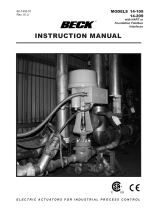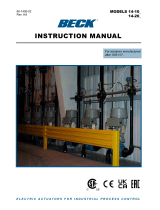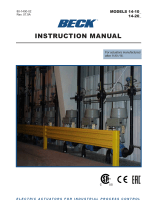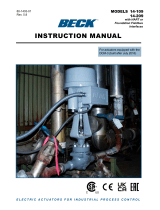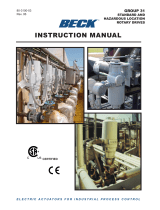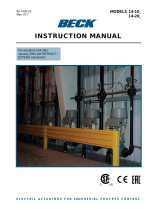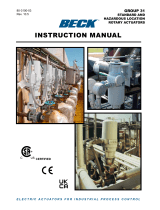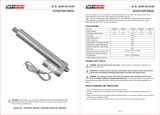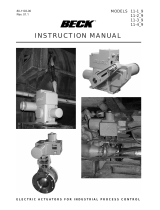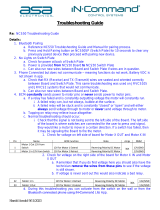Page is loading ...

80-1402-03
Rev. 03.5
14-109
14-209
MODELS
INSTRUCTION MANUAL
R
For actuators equipped with
the CPS-5 (built after
February 2016)

2
80-1402-03
INTRODUCTION
This manual contains the information needed to
install, operate and maintain Beck Model Group 14
Electric Actuators equipped with the Digital Control
Module (DCM-2), manufactured by Harold Beck &
Sons, Inc. of Newtown, Pennsylvania.
NOTICE: This manual contains information
that will make installation simple, efcient and
trouble-free. Please read and understand the
appropriate sections in this manual before
attempting to install or operate your actuator.
Group 22 digital actuators ...
are designed for accurate, reliable,
digital control in high torque
applications. The actuator is ideal
for use in large boiler applications,
such as ID/FD fan dampers.
Group 11 rotary actuators ...
provide precise position control of dampers,
quarter-turn valves, fluid couplings, and
other devices requiring up to 1,800 lb-ft
(2 440 N•m) actuator torque.
The Group 14 linear actuator is a powerful
control package designed to provide precise
position control of globe valves and other devices
requiring up to 4,000 lbs (17 800 N) of thrust.

3
80-1402-03
TABLE OF CONTENTS
Introduction ......................................................................................................................2
General Specications ....................................................................................................4
Outline Dimension Drawings ..........................................................................................6
Precautionary Information ..............................................................................................8
General Operation Information .......................................................................................9
Installation ......................................................................................................................10
Mechanical .................................................................................................................10
Electrical .................................................................................................................... 11
Wiring .........................................................................................................................12
Start-up ...........................................................................................................................13
Components ...................................................................................................................14
Mechanical .................................................................................................................14
Electronics .................................................................................................................16
Conguration/Calibration .............................................................................................20
Maintenance ...................................................................................................................36
Troubleshooting .............................................................................................................46
Appendices ....................................................................................................................51
HART® Communication ............................................................................................51
HART® Messages ......................................................................................................57
Serial Communication ..............................................................................................60
Serial Commands ......................................................................................................61
Index ...............................................................................................................................70
Services ..........................................................................................................................71

4
80-1402-03
Actuator
Power
120 V ac, single-phase, 60 Hz (Standard), 50 Hz (Optional)
48, 72 or 180 watts
240 V ac, 50 or 60 Hz (Optional)
Allowable Tolerance +10%
-15%
14-109 .56 A 72 W .33 A 80 W
14-209 1.5 A 180 W .86 A 210 W
Operating Conditions -40° to 85°C (-40° to 185°F)
0 to 100% relative humidity
Communication Interface HART protocol (Rev. 5 -- burst mode is not supported)
Pushbutton / LED panel
RS-232 Serial commands
Demand Input Signal
Options
4–20 mA (1–5 V dc input is possible with the removal of the “R11”
resistor located on the DCM-2 board (see diagram on page 60)
Adjustability for Split Range
Operation
0%: 0.1 V to 4 V dc
100%: 0% + 1 V min. to 5 V max.
Minimum Step Size 0.1% (0.15% typical, congurable from 0.1 to 2.5%)
Linearity ±1% of span, max. independent error
Hysteresis 0.25% of span at any point
Demand input Signal
Characterization
Linear: Actuator output shaft moves proportionally to the input signal
Square: Actuator output shaft moves proportionally to the square of
the input signal
Square Root: Actuator output shaft moves proportionally to the
square root of the input signal
Custom: Actuator output shaft moves according to the congurable
10-segment response curve
Position Feedback Signal 4–20 mA
Isolation Demand input and position Feedback signals are isolated from ground
and the AC power line. Signal buffering provides 24 V dc isolation
between the Demand and Feedback signals
Action on Loss of Power Stays in place
Action on Loss of Input Signal Stays in place or actuators to any preset position (congurable)
Stall Protection If the motor tries to run in one direction for more than 300 seconds
(congurable from 30 to 450 seconds), the DCM-2 will shut off power to
the motor (feature can be enabled/disabled) - factory default is enabled.
GENERAL SPECIFICATIONS

5
80-1402-03
Alarm Annunciation Available at terminal E.
Temperature Indication Measures the internal temperature of the actuator and triggers an alarm
when the temperature exceeds the rating.
Over-travel Limit Switches Two SPDT switches (Retract and Extend) provide over-travel protection.
Auxiliary Switches Up to four 6 A, 120 V ac switches available.
Switches are labeled S1 to S4 and are cam-operated, eld-adjustable.
Handswitch Permits local electrical operation, independent of controller signal.
Standard on all units. An auxiliary contact is available as an option for
remote auto indication (rated 2.5 A at 120 V ac).
Handwheel Provides manual operation without electrical power.
Motor Assembly 120 V ac, single-phase, no-burnout, non-coasting motor has instant
magnetic braking. Requires no contacts or moving parts.
Gear Train High-efciency, precision-cut, heat-treated alloy steel and ductile iron
gears and bronze nut. Interchangeable gear modules permit eld
change of timing.
Mechanical Stops Prevent overtravel during automatic or manual operation.
Enclosure Precision-machined, aluminum alloy castings painted with corrosion-
resistant polyurethane paint provide a rugged, dust-tight, weatherproof
enclosure. Type 4; IP66.
Stroke Adjustment Calibar simultaneously adjusts the stroke length, position feedback
signal, over-travel limit switches and auxiliary switches. The new
stroke displacement is produced by the full input signal.
Mounting Orientation Any orientation—no limitations.
Standards CSA Labeled (US & Canada); CE Compliant
Basic
Model
Thrust
(lbs. / N)
Timing -- sec./in. (sec./cm.) Dimensional
Data
@ 60 Hz @ 50 Hz
14-100
340 / 1 513 4 (1.6) 5 (2)
Pages 6 & 7
425 / 1 891 11 (4.3) 13 (5.1)
600 / 2 670 16 (6.3) 19 (7.5)
650 / 2 893 8 (3.1) 10 (3.9)
800 / 3 560 11 (4.3) 13 (5.1)
1,000 / 4 450 27 (10.6) 32 (12.6)
1,100 / 4 895 16 (6.3) 19 (7.5)
1,620 / 7 209 48 (18.9) 57 (22.4)
1,800 / 8 010 27 (10.6) 32 (12.6)
14-200 2,700 / 12 015 16 (6.3) 20 (7.9)
4,000 / 17 800 24 (9.4) 29 (11.4)

6
80-1402-03
5/16 [8] to 2 1/8 [54] travel (Dimensions in inches & [mm] )
Beck Model 14-100 & -200
NOTE: Actuators may be mounted in any orientation.
Beck
Model
No.
Actuator Shaft
Travel Range
(in) [mm]
"A"
Valve Boss
Dia. Range
(in) [mm]
"B"
Yoke
Height
(in) [mm]
"C"
Nominal Drive
Shaft Extension
(in) [mm]
Max. Valve Stem
Extension (Valve
Stem Retracted
(in) [mm]
Approx.
Weight
(lb) [kg]
14-100 5/16–1 3/4 [8–44] 1–2 5/8 [25–67] 8 [203] 4 3/16 [106] 5 1/2 [140] 80 [36]
3/4–2 1/8 [19–54] 1 3/8–3 3/4 [35–95] 13 1/2 [343] 6 [152] 9 1/4 [235] 92 [42]
14-200 5/16–1 3/4 [8–44] 1 3/8–3 3/4 [35–95] 13 1/2 [343] 6 11/16 [170] 9 [229] 105 [48]
3/4–2 1/8 [19–54] 1 3/8–3 3/4 [35–95] 13 1/2 [343] 6 11/16 [170] 9 [229] 105 [48]
MODEL 14-100MODEL 14-200
OUTLINE DIMENSION DRAWINGS

7
80-1402-03
3/4 [19] to 4 1/2 [114] travel (Dimensions in inches & [mm] )
NOTE: Actuators may be mounted in any orientation.
Beck Model 14-100 & -200
Beck
Model
No.
Actuator Shaft
Travel Range
(in) [mm]
"A"
Valve Boss
Dia. Range
(in) [mm]
"B"
Yoke
Height
(in) [mm]
"C"
Nominal Drive
Shaft Extension
(in) [mm]
Max. Valve Stem
Extension (Valve
Stem Retracted
(in) [mm]
Approx.
Weight
(lb) [kg]
14-100 3/4–3 1/2 [19–89] 1 3/8–3 3/4 [35–95] 19 13/16 [503] 12 5/16 [313] 9 1/4 [235] 100 [45]
1 3/4–4 1/2 [44–114] 1 3/8–3 3/4 [35–95] 19 13/16 [503] 12 5/16 [313] 9 1/4 [235] 100 [45]
14-200 3/4–3 1/2 [19–89] 1 3/8–3 3/4 [35–95] 19 13/16 [503] 13 [330] 9 1/4 [235] 113 [51]
1 3/4–4 1/2 [44–114] 1 3/8–3 3/4 [35–95] 19 13/16 [503] 13 [330] 9 1/4 [235] 113 [51]
MODEL 14-100MODEL 14-200

8
80-1402-03
PRECAUTIONARY INFORMATION
SAFETY PRECAUTIONS
WARNING
Installation and service instructions
are for use by qualied personnel
only. To avoid injury and electric
shock, do not perform any servicing
other than that contained in this
manual. Please read and understand
the appropriate sections in this
manual before attempting to install
or operate your actuator.
STORAGE INFORMATION
Beck actuators should be stored in a clean,
dry area where the temperature is between -40°
and 85°C (-40° to 185°F).
Damage due to moisture while in storage is
not covered by warranty.
INSTALLATION—MECHANICAL
There are many considerations regarding
proper mechanical installation—see the
instructions beginning on page 10 for details. Refer
to the outline dimension drawings on pages 6 & 7
for physical dimensions and required clearances.
VALVE ACTUATOR INSTALLATIONS
CAUTION
Working with valves installed in a
pipeline can be dangerous. Take
appropriate precautions when
mounting to installed valves.
INSTALLATION—ELECTRICAL
See the instructions beginning on page 11 for
details regarding electrical installation.
CAUTION
For maximum safety, the Beck
actuator body should be grounded.
Use the green grounding screw
in the wiring compartment of the
actuator.
CAUTION
Always close covers immediately
after installation or service to prevent
moisture or other foreign matter
from entering the actuator.

9
80-1402-03
GENERAL OPERATION INFORMATION
HANDSWITCH
A Handswitch allows local electric control at
the actuator. In either of the STOP
positions, the motor is blocked
from running. In the RETRACT
or EXTEND positions, the
motor runs to move the output
shaft in the corresponding
direction. When moving the output shaft using
the Handswitch, the motor will stop when the over-
travel limit switches are reached.
The Demand signal can position the actuator
only when the Handswitch is in the AUTO position.
AUTOMATIC MODE
When the Handswitch is placed in the AUTO
position, the actuator is in automatic mode and
responds to a Demand signal (also called the
setpoint). The Digital Control Module (DCM-2)
compares the Demand signal with the output shaft
position. When the DCM-2 detects a difference
between Demand and Position (called error), the
motor will move the output shaft until the Position
matches the Demand.
MODES OF OPERATION
There are three basic modes of operation:
• Handwheel—local mechanical control
• Handswitch—local electrical control
• Automatic—remote electrical control
Any or all of these modes can be used to test basic
operation of your actuator during start-up.
HANDWHEEL
The Handwheel permits manual operation
of the actuator without power. The Handwheel is
coupled directly to the motor shaft at the rear of the
motor housing and it rotates when the motor runs.
The Handwheel is particularly useful during
initial installation or when power is not available. If
power is available, the Handswitch must be moved
to the STOP position before manually operating
the Handwheel.
ContaCtless Position
sensor (CPs)
switChes
handwheel
digital Control Module (dCM-2)
and wiring terMinal Board CoMPartMent
tight-seater™
CouPling
Motor
gear Cover Plate
handswitCh

10
80-1402-03
UNITIZED VALVE/ACTUATOR
ASSEMBLY INSTALLATION
Beck actuators can be furnished with valves
mounted as unitized assemblies ready for pipeline
installation. To install:
Inspect the valve and pipe flanges to ensure they
are clean. Be certain that other pipelines in the area
are free from pipe scale or welding slag that could
damage the gasket surfaces.
Carefully lift the assembly and position the valve in
the pipeline. Install and tighten the flange bolts according
to the valve and/or gasket manufacturer’s instructions.
NOTE: The valve may have undergone
temperature variations in shipment. This could
result in seepage past the stem seals. Refer to the
valve manufacturer’s maintenance instructions
for packing adjustments, if required.
VALVE ACTUATOR INSTALLATION
Whenever an actuator is being mounted on a valve,
refer to the valve manufacturer's maintenance manual
for specific valve-related instructions. Consult the Beck
Valve Mounting Specification sheet shipped with the
actuator for specific instructions on assembly of the Beck
actuator and mounting hardware to the valve. It is good
practice to remove the valve from service if possible.
CAUTION
Working with valves installed in a
pipeline can be dangerous. Take
appropriate precautions when mounting
to installed valves.
Mounting The Actuator On A Valve
See figure at right to identify mounting parts.
Follow the steps to install the actuator onto the valve.
1. Prepare the valve. It may be necessary to
remove parts that are no longer used or to
replace or adjust packing. Refer to the valve
maintenance manual for specific instructions.
Consult the Beck Valve Mounting Specication
sheet that was shipped with the actuator for any
instructions regarding modications to the valve
stem that may be necessary.
2. Push the valve stem into the valve body to the
fully seated or stem down position.
3. Move the G-14 output shaft up into the actuator
body until the upper mechanical stop is tight
against the lower bearing plate .
4. Remove the four lower bearing plate bolts that
hold the bottom plate to the actuator body (1/2"
bolt heads). Pressure from the mechanical stop
will hold the plate in place when the bolts are
removed. Bolt the yoke to the lower bearing
plate using the longer bolts supplied with the
yoke. Torque bolts to 10 Ib-ft (13.5 N•m).
5. Place the jam nuts and travel index over the valve
stem before mounting the actuator on the valve.
6. Remove the boss nut from the valve and place the
actuator and yoke over the stem and onto the boss
. Secure the yoke with the boss nut, hand-tight.
7. Using the actuator Handwheel, lower the actuator
output shaft to contact the valve stem. Thread the
valve stem into the end of the actuator output shaft.
HINT: Rotate the whole yoke/actuator assembly to
get the valve stem started into the actuator output
shaft. Continue lowering the actuator output shaft
and threading the valve stem until the actuator
output shaft is fully down on the mechanical stop.
8. Tighten the boss nut to secure the yoke and tighten
the yoke set screw .
9. Follow the valve seating adjustment procedure on
page 13 to complete the mounting.
Removing the Actuator from a Valve
1. Move the Group 14 output shaft up into the
actuator body until the mechanical stop is tight
against the lower bearing plate .
2. Turn off all electrical power and disconnect all
electrical wiring from the actuator.
3. Loosen the valve stem jam nuts . Loosen the
boss nut on the yoke and leave it nger tight.
Loosen the yoke set screw .
4. Unthread the valve stem from the actuator output
shaft by turning the whole yoke/ actuator assembly.
INSTALLATION
4
0
1
2
3
1
2
3
5
7
8
10
4
6
9

11
80-1402-03
ELECTRICAL INSTALLATION
Two conduit connections are provided in every
Beck Group 14 actuator for supplying power and
signal wiring to the unit. A sealant must be used on
threaded conduit connections to keep moisture out.
Conduits should be routed from below the actuator
so that condensation and other contaminants
entering the conduit cannot enter the actuator.
To maintain signal integrity and meet most
electrical codes, power and signal wires must be
routed to the actuator separately. The signal wiring
should be either shielded cables or be installed in
conductive conduit and/or cable trays.
A large, clearly labeled terminal block on the
side of the actuator is enclosed in a gasketed metal
enclosure. Terminals will accommodate up to 12
AWG (3.31 mm2) wiring (see gure on page 12).
CAUTION
Always close covers immediately
after installation or service to prevent
moisture or other foreign matter
from entering the actuator.
Refer to the wiring diagram furnished with
your Beck actuator for proper AC power and
signal connections. It is advisable to provide
normal short circuit protection on the AC power
line. A copy of the wiring diagram is shipped with
each actuator and is fastened to the inside of the
terminal block cover. If there is no wiring diagram
available, you may obtain a copy from Beck by
providing the serial number of your actuator.
Your Beck actuator has been supplied to
match the signal source in your control loop.
If it does not match, the input signal range is
convertible by adding or removing a 250 ohm
resistor—contact the factory for details.
For maximum safety, the Beck actuator body
should be grounded. Normally, the electrical
conduit provides adequate ground protection.
If not, a separate ground conductor should be
connected to the actuator body.
TERMINAL SCREW TORQUES
Each terminal screw should be torqued to the
proper specification upon landing the wire.
All Models A–V 16 1.8
AA–EE 12 1.4
INSTALLATION
POWER QUALITY
Power quality disturbances such as power
outages, transient voltages, harmonic distortions,
and electrical noise will adversely affect your
actuator performance. Protecting your actuator
from these conditions can reduce downtime and
promote longer life for the equipment. Following
the industry accepted standards below will help
protect your actuator.
aaSelect wiring materials according to the
correct ampacity ratings dictated by national
and local regulations.
aaShielded, twisted pair cables can be used for
signal connections to avoid being affected by
electrical noise. These signal wires, based
on Noise Susceptibility Level (NSL) per
IEEE-518, fall into the level 1 classification.
A braided shield will be more effective than
a wrapped foil shield. Signal wire shields
should be connected to the actuator casting
grounding screw. If grounding at the signal
source is required, then the shield should not
be grounded at the actuator.
aaRaceways such as conduits and trays must
be grounded at both ends to properly meet
immunity requirements.
aaAn AC power ground connection should be
made between the power source and the Beck
actuator. Grounding connections including
wire and metal conduit are permitted, but the
actuator-grounding conductor may not be
connected to a structured metal frame of a
building.
aaSurge suppression equipment that meets
Underwriters Laboratory (UL) Standard 1449
may be used to protect against transient
voltage conditions.
aaPower Conditioners may be used to regulate
the supply voltage and maintain a constant
voltage level. They are helpful in protection
against voltage sags and swells, as well as
some measure of electrical noise protection.
aaHarmonic lters may be used to minimize the
effects of supply voltage waveform distortions
and are used in applications that incur a large
amount of high-frequency electronic noise.
CAUTION
Always close covers immediately
after installation or service to prevent
moisture or other foreign matter
from entering the actuator.

12
80-1402-03
Each Beck actuator is custom built to match
the control requirements of your system specied
at the time of order. Typical wiring connections
are described below. Each actuator has a
specic wiring diagram attached to the inside of
the wiring terminal cover.
An actuator can be ordered with up to four
optional auxiliary switches. Wiring connections
for these are described on page 21.
Typical Wiring Connections
INSTALLATION

13
80-1402-03
START-UP CHECKLIST
The following list provides some basic checks
that should be performed before placing your
actuator into operation.
Inspect the location and the mounting bolts. Be
sure the actuator is securely fastened to the
valve.
On the rst start-up, place the Handswitch in a
STOP position to ensure that the output shaft will
not move and possibly cause personal injury.
Conrm the actuator is receiving the appropriate
operating voltage as shown on the nameplate.
Check the DCM-2 Power LED. It should be
pulsing (Dim/Bright) to indicate the board is
active.
Using the Handswitch, conrm the actuator
moves fully to both the RETRACT and EXTEND
ends of travel.
Conrm the actuator has a 4–20 mA Demand
signal attached to terminals AA (+) and BB (–).
Place the Handswitch in AUTO and vary your
Demand signal from 0% to 100%.
Check for the Status alarm LED on the DCM-2.
If it is lit, refer to the Troubleshooting section of
this manual.
Verify that the output shaft is moving to the
desired 0% position with a 0% Demand signal
and moving to the 100% position with a 100%
Demand signal. If they are reversed, see the
Conguration/Calibration section of this manual
for instructions on how to change the direction
of output shaft rotation.
Valve Seating Adjustment
The actuator has a Tight-Seater™ attached
to its output shaft. The Tight-Seater™ allows
tight seating of the valve plug. It is a pre-loaded
coupling that allows the valve plug to seat
before the actuator reaches its lower limit. The
additional amount of travel compresses the
thrust discs inside the Tight-Seater™, causing a
controlled amount of thrust to hold the valve plug
on its seat when the actuator stem reaches its
lower limit. The Tight-Seater™ is factory-set to
produce a thrust matched to the valve and should
never be disassembled. Control of the amount of
valve stem threaded into the Tight-Seater™ may
be used to adjust the valve seating.
If readjustment of valve seating is necessary,
proceed as follows:
1. With the Handswitch, run the actuator to a
position above the 0% or lower limit position.
2. Loosen the lock nut on the valve stem and
thread the valve stem into the Tight-Seater™.
3. Run the actuator to the 0% position, using a
Demand signal source.
4. Thread the valve stem out of the Tight-Seater™
until the plug seats in the valve.
5. Raise the actuator shaft using the Handswitch
until the plug is clear of the seat and there
is sufcient clearance to make the following
adjustment.
6. Thread the valve stem out of the Tight-Seater™
a fraction of a turn according to the valve stem
thread as listed (1/32" travel):
Thread Turn
3/8-24 3/4
7/16-18 5/8
1/2-20 5/8
3/4-16 1/2
7. Tighten the lock nut and index disc on the valve
stem.
8. Run the actuator to its lower limit using the
Handswitch. The valve stem should stop
before the actuator shaft stops.
9. Reposition the travel index.
CAUTION
If the valve stem is threaded directly
into the actuator shaft without
a Tight-Seater™, the valve stem
should be at least 1/4 turn from
the seated plug position when the
actuator shaft reaches the lower
limit. This will prevent damage to the
valve stem or seat. Do not attempt
to obtain tight shut-off without a
Tight-Seater™ as serious valve
damage may result.
START-UP

14
80-1402-03
HOUSING
All models of the Beck Group 14 actuator
have individual, cast aluminum compartments for
the main components: The control motor, wiring
terminal board, actuator train, Digital Control
Module, and feedback section. Gasketed covers
and sealed shafts make this product ideally suited
for outdoor and high-humidity environments.
CONTROL MOTOR
The Beck control motor is a synchronous
inductor motor that operates at a constant
speed of 72 RPM in synchronism with the line
frequency.
Motors are able to reach full speed within 25
milliseconds and stop within 20 milliseconds;
actual starting and stopping times vary with load.
Beck motors have double grease-sealed
bearings and require no maintenance for the life
of the motor.
DRIVE TRAIN
The Group 14 drive train consists of a control
motor, SLM, Handwheel, reduction gears, main
gear, and power screw output shaft. The ductile
iron main gear and the bronze nut and stainless
steel power screw output shaft are common to units
of a particular range of thrust and timing. The steel
reduction gears are part of the eld changeable
gear housing assembly. Different combinations
of output gear, housing assemblies, and actuator
motors determine the actuator’s output thrust,
timing and stroke adjustment.
The output shaft travel is limited by mechanical
stops. The mechanical stop for the fully extended
or lower limit of the output shaft travel is not
adjustable. The position of the retracted or upward
travel mechanical stop is determined by the
number of washers on the output shaft between the
Tight-Seater™ and the lower bearing plate. This
is factory-set for the amount of travel specied at
the time of the order and is generally not changed
in the eld.
The amount of output shaft travel is determined
by the setting of the Calibar. Moving the Calibar
block away from the output shaft increases the
radius where the ball bearing contacts the sector
gear lever. The longer the radius the longer the
vertical stroke of the output shaft for the same
amount of rotation of the control end shaft.
Therefore, the Calibar changes the output shaft
travel but makes it unnecessary to change the
switch cams or CPS-5. Field Calibar adjustment
is generally used to shorten the travel. Consult
the factory if a longer stroke is required.
SELF-LOCKING
MECHANISM (SLM)
An integral part of every Group 14 control
motor is the self-locking mechanism. This
mechanical device couples the motor to the
gear train and transmits full motor torque when
rotated in either direction. When the motor is
de-energized, it instantaneously locks and holds
the output shaft in position.
COMPONENTS

15
80-1402-03
TIGHT-SEATER™
The Beck Tight-Seater™ assembly is a pre-
loaded coupling that is installed between the
actuator output shaft and the valve stem. It
produces a controlled positive pressure against
the valve seat, independent of actuator thrust.
The Tight-Seater™ consists of four parts: A
housing attached to the output shaft, linear thrust
discs contained in the housing, a anged coupling
attached to the valve stem, and a threaded ring
to contain the anged coupling in the housing
and to allow adjustment of the pre-load on linear
thrust discs.
The factory pre-load, by a threaded ring,
ensures that no relative motion occurs between
the anged coupling and housing during normal
valve operation until the pre-load thrust is
exceeded in the seated plug position of the
valve.
When the seated plug position of the valve is
reached, the anged coupling on the valve stem
is stationary, and the output shaft exceeds the
pre-load pressure of the Tight-Seater™. When
the pre-loaded pressure is exceeded, the housing
will compress the linear thrust discs, maintaining
a controlled pressure on the valve seat, with the
shaft stationary.
HANDWHEEL
Every Beck Group 14 linear actuator is
furnished with a Handwheel for operation of
the valve without electrical power. Its solid
construction design includes no spokes or
projections, and turns at a safe, slow speed. The
Handwheel is located at the bottom of the control
motor housing. The Handwheel is coupled
directly to the motor shaft and rotates when the
motor runs. Manual operation of the Handwheel
(with electric Handswitch in STOP position)
turns the motor and the rest of the actuator train
without incorporating a clutch.
HANDSWITCH
A local electric Handswitch is provided on
Beck actuators to permit operation at the valve,
independent of the controller. As a safety
feature, the Handswitch is designed so that the
controller can operate the actuator only when it
is in the AUTO position. The sequence of the
Handswitch is: AUTO, STOP, RETRACT, STOP,
EXTEND.
In the AUTO position, two contacts are closed
and the DCM-2 contact completes the control
circuit.
In the RETRACT or EXTEND positions,
contacts are closed to operate the actuator
independently of the controller.
In the STOP position, all contacts remain
open.
SWITCHES
Two over-travel limit switches and up to
four optional auxiliary switches are provided
on Group 14 actuators. Switch cams are
clamped onto the control shaft, which rotates
in relation to the output shaft. Cam position
is field-adjustable. Switches are enclosed in
high-impact thermoplastic. Switches are rated 6
A, 120 V ac (0.5 A, 125 V dc). All auxiliary switch
connections are made on the terminal board.
Tight-Seater™
TIGHT-SEATER
COUPLING
TM
DIRECTION OF
COMPRESSION
VALVE STEM CONNECTION
(MOVEABLE COUPLING TO
COMPRESS DISKS)
ACTUATOR OUTPUT SHAFT
CONNECTION
TIGHT-SEATER HOUSING
LINEAR THRUST DISKS
(NUMBER OF DISKS
VARIES WITH RATED
THRUST OF VALVE)
THREADED RING TO
CONTAIN MOVEABLE
COUPLING

16
80-1402-03
CONTROL & CONTACTLESS
POSITION SENSOR (CPS-5)
The actuator top cover houses the limit switch
assemblies and the Contactless Position Sensor
(CPS-5). The CPS-5 is the electro-mechanical
device that provides the DCM-2 with a continuous
feedback signal proportional to the position of the
actuator’s output shaft.
The control area includes a control shaft,
which is geared directly to the output shaft of the
actuator. Movement of the output shaft causes
rotation of the control shaft, which in turn moves
the limit switch cams and the CPS-5 ferrite rotor.
A ferrite magnetic sensing element generates a
voltage as the rotor turns. The voltage is translated
into a position signal voltage used by the DCM-2 to
control the actuator.
The typical position signal voltage of the
CPS-5 ranges from 1.0 V dc at the Extend end
of travel, to 5.0 V dc at the Retract end of travel.
The DCM-2 can be calibrated to interpret CPS-5
position signals between 0.3 V dc and 5.3 V dc.
Position signal voltages can be measured on the
yellow (+) and green (R) position signal wires
located on the CPS-5. The CPS-5 power is derived
from the blue and black wires on the primary side
of the transformer. 120 V ac can be measured
across the transformer tabs (blue and black wires).
There are two SPDT over-travel limit switch
assemblies (labeled “EXT” and “RET”) and up
to four auxiliary switch assemblies (labeled “S1”
through “S4”).
DIGITAL CONTROL MODULE
(DCM-2)
The DCM-2 is a micro-processor based circuit
board assembly that serves as the actuator’s
control center.
The main function of the DCM-2 is to position
the actuator’s output shaft. The DCM-2 compares
the 4–20 mA Demand signal received at the
actuator terminals AA(+) and BB (–) to the actuator
position signal, generated from the Contactless
Position Sensor (CPS-5). If a difference exists
(called error) between the Demand and Position
signals, the DCM-2 activates triacs that operate
the motor. The motor drives the gear train and
positions the output shaft until the difference is
eliminated.
The DCM-2 layout is shown on page 18 and
includes the fuse and test point locations. The
typical position signal voltage from the CPS-5
(measured from TP1(–) and TP4(+)) ranges from
1.0 V dc at the Extend end of output shaft travel,
to 5.0 V dc at the Retract end of output shaft
travel. Test point voltage levels between TP2(+)
and TP3(–) across the input resistor R11 should
read between 1 V dc and 5 V dc proportional to the
4–20 mA Demand signal.
COMPONENTS
(R)
(+)

17
80-1402-03
INTERFACES
The DCM-2 has three configuration interfaces: Pushbutton, HART, and Serial Port.
The DCM-2 board is equipped with a pushbutton panel that can be used to calibrate the Demand signal and
congure 0% and 100% positions. It may also be used to congure the direction of output shaft rotation
for increasing Demand. These congurations and calibrations do not require any external equipment to
perform.
The HART interface is accessible by connecting a HART capable communication device (such as
a handheld communicator) to terminals AA (+) and BB (–) of the terminal block area. A HART-capable,
analog output can be used for the Demand signal as well. All electronic calibration and conguration can
be accomplished through the HART interface. NOTE: The appropriate HART device descriptions are
required.
The Serial port interface is accessible by connecting a computer to the DCM-2 using a Beck Serial cable.
See the Serial Communications appendix for details on connecting via the Serial port. All electronic
calibration and conguration can be accomplished through the Serial port interface.
DCM-2
Pushbutton Panel
Computer
Beck Serial
Cable
RS-232
Serial Port
Communicator
Terminal Block
AA & BB
HART
Cable

18
80-1402-03
OVERVIEW LEDS
There are four LEDs that reside on the main
DCM-2 board (pictured above). These LEDs
indicate the basic, real-time state of the actuator.
A description of each LED follows.
FWD
This LED illuminates when the actuator is
receiving a Demand signal greater than its
position.
REV
This LED illuminates when the actuator is
receiving a Demand signal less than its
position.
STAT
This LED illuminates during a system alarm.
Explanation of the specic alarm is available
through the eldbus or Serial interface. See
the Troubleshooting section for additional
information.
PWR
This LED illuminates when power is applied to
the actuator. This LED pulses from bright to
dim indicating the DCM-2 is operational.
Mounting
sCrews
Mounting
sCrews
status
overview leds
serial Port
Fuse
test Point 4
(tP4)
test Point 3
(tP3)
on Main Board,
r11 resistor
test Point 2
(tP2)
on Main Board,
r11 resistor
test Point 1
(tP1)
status
indiCation leds
PushButtons
COMPONENTS

19
80-1402-03
STATUS INDICATION LEDs
When the “STAT” LED is lit, the applicable
status indication LED(s) (pictured below) will light
to reveal the condition(s) as described below. An
alarm is also available at terminal E. When the
condition is corrected, the status will automatically
reset. Each status LED is described below.
DEMAND
Loss of the Demand input signal.
POSITION
The Position signal to the DCM-2 is out of the
calibrated range limits. The lower limit is –5%
and the upper limit is 105% of the calibrated
range. This LED may also indicate a lm
potentiometer or internal wiring failure.
TORQ/THRUST
This LED is inactive for Group 14 actuators.
STALL
The actuator is in a stall condition and stall
protection has been activated.
TEMP °F.
Drive’s internal temperature is outside of rating.
FB OPEN
External position Feedback signal is enabled,
but not wired to an external load or the wiring
has failed between the actuator and the
monitoring device.
STOP/LIMIT
Handswitch is in “STOP” position or the
actuator is at a limit and is not in balance.
ACKNOWLEDGE
Indicates when a calibration procedure has
been completed.
PUSHBUTTON CONTROLS
The five pushbuttons (pictured below) on the
DCM-2 customer interface panel are used for
calibration. When pressing a pushbutton, pressure
should be maintained until the “ACKNOWLEDGE”
LED lights; this confirms receipt of the pushbutton
command. See the Configuration/Calibration
section of this manual for further explanation of
calibration procedures.
CALIBRATE
This button must be pressed and held
simultaneously with another pushbutton to
perform a calibration.
CAUTION
Pressing the following buttons may
change calibration and cause the
actuator to reposition.
SET POS 100%
Press to designate the current position of the
output shaft as the 100% position for actuator
movement (this will correspond to a 100%
Demand signal).
SET POS 0%
Press to designate the current position of the
output shaft as the 0% position for actuator
movement (this will correspond to a 0%
Demand signal).
SET DEM 100%
Press to designate the current Demand input
signal as 100% Demand.
SET DEM 0%
Press to designate the current Demand input
signal as 0% Demand.

20
80-1402-03
All Beck actuators are shipped completely
calibrated to the customer’s specications that
were written into the equipment order and are
ready to be installed. If the need arises to change
the actuator calibration, first confirm that the
actuator is installed as specied and operating
properly before proceeding with the change.
Position reference and Demand calibration are
performed using the DCM-2 customer interface
panel, but may also be congured using the HART
or Serial interface. Calibration of over-travel limit
and auxiliary switches must be performed using
the procedure beginning on page 21.
CALIBRATION PRIORITY
Standard Group 14 actuators are equipped
with built in mechanical stops. All output shaft
movement must occur within these stops.
The over-travel limit switches are used to limit
the electrical control range of the actuator. These
switches are cam operated, and are set slightly
wider apart than the actuator's intended full range
of electronic operation. With this range, the limit
switch cams are each set inside the mechanical
stops, and are positioned to provide an electrical
over-travel protection without opening in the
normal operating range. If the actuator stroke is
changed by adjusting the calibar (see page 23),
the limit switches are simultaneously adjusted.
The auxiliary limit switches are also cam
operated, but have no affect on actuator and
DCM operation. Therefore, they can be adjusted
at any time without affecting performance or
calibration.
CONFIGURATION/CALIBRATION
/
